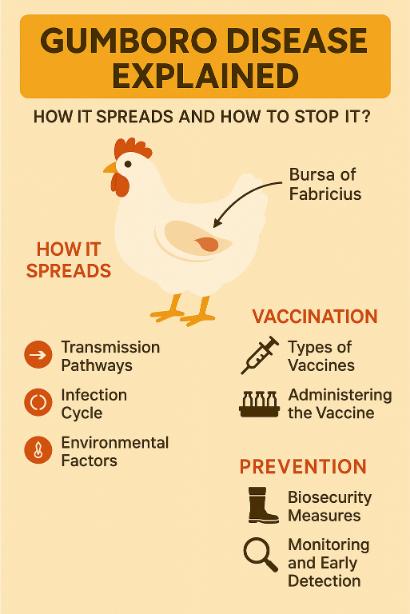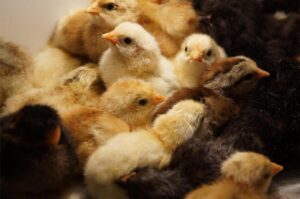Gumboro Disease Explained: How It Spreads and How to Stop It ?
In the rhythmic clatter of feathers and the soft clucks of poultry farms, an undercurrent of anxiety whispers through the avian world. Gumboro Disease, a formidable adversary, silently lurks in the bursa of our feathered companions.
As chicken owners and poultry producers, understanding this mysterious infection is more than just a curiosity ; it’s a necessity. With the potential to decimate entire flocks, this infectious disease demands our attention, vigilance, and proactive measures.
Let’s unravel the mysteries of Gumboro Disease, its causes, its spread, and most importantly, how we can stop it in its tracks.
Understanding Gumboro Disease
What exactly is Gumboro Disease ? Known scientifically as Infectious Bursal Disease Virus (IBDV), it is a highly contagious virus affecting young chickens. The disease primarily targets the bursa of Fabricius, an organ unique to birds involved in their immune system development.
Identifying the Culprits
The virus’s particles are resilient, capable of surviving in the environment for long periods. Discovered in the 1960s, IBDV’s genetic adaptability has led to the emergence of various strains, each with varying degrees of virulence. These strains can disrupt poultry production operations, leading to indirect economic losses due to compromised immunity and increased susceptibility to secondary infections.

Symptoms and Clinical Signs
Recognizing the symptoms of Gumboro is vital. Chickens may exhibit ruffled feathers, depression, and watery diarrhea. Clinical signs can vary based on the strain and the age of the birds, with younger chickens typically being more susceptible. In extreme cases, the disease can lead to significant mortality, leaving a path of destruction in its wake.
Combating Gumboro requires vigilance, knowledge, and action, making it essential for poultry producers to educate themselves about this avian adversary.
How Gumboro Disease Spreads ?
In the world of avian diseases, Gumboro spreads with insidious efficiency. Understanding its transmission is crucial for prevention and control.
Transmission Pathways
The virus spreads primarily through direct contact, contaminated feed, water, or environments. The resilient nature of the virus allows it to persist on farm equipment, clothing, and even wild birds that inadvertently become vectors, acting as carriers of the disease.
Infection Cycle
Once the virus enters a farm, it swiftly infiltrates through the bursa of the young chickens. The clinical infection may not manifest immediately, allowing the virus to spread surreptitiously among the flock. This silent transmission can lead to a delayed response from producers, exacerbating the outbreak.
Environmental Factors
Environmental conditions, such as temperature and humidity, can influence the virus’s survival and transmission. Well-managed farms with stringent hygiene protocols are less likely to experience outbreaks, highlighting the importance of maintaining optimal conditions to reduce the risk of infection.
By understanding the vectors and conditions that facilitate its spread, poultry producers can better equip themselves to combat this disease.
Vaccination: The Shield Against Gumboro
Vaccination is the cornerstone in the fight against Gumboro Disease. A targeted and strategic vaccination plan can safeguard flocks, ensuring the health and productivity of poultry operations.
Types of Vaccines
There are two primary vaccine types: live attenuated and inactivated vaccines.
Live vaccines offer robust immunity but may require careful handling to prevent adverse reactions.
Inactivated vaccines, on the other hand, are safer but may offer lesser protection.

Administering the Vaccine
The administration of vaccines must be done meticulously, considering factors such as the age of the flock and the prevalent strains. Vaccination schedules are crucial, with recommendations often available through local veterinary services or resources like PubMed and academic journals.
Challenges and Considerations
While vaccination is effective, it isn’t without challenges. The emergence of new strains and the potential for vaccine failure due to improper administration or handling require constant vigilance and adaptation. Regular monitoring and updates to the vaccination strategy can help in minimizing these risks.
Incorporating a comprehensive vaccination regimen is an effective strategy to mitigate the risk of Gumboro Disease, protecting both the birds and the producers’s livelihood.
Strategies to Prevent and Control Gumboro Disease
Beyond vaccination, integrating a multifaceted approach can bolster defenses against Gumboro Disease. Prevention is often more cost-effective than treatment, making these strategies essential for any poultry operation.
Biosecurity Measures
Implementing rigorous biosecurity protocols is paramount. This includes controlling farm access, disinfecting equipment, and maintaining sanitary conditions. Regularly cleaning and disinfecting the farm environment can reduce the potential for virus survival and transmission.
Monitoring and Early Detection
Regular monitoring of flocks for early signs of the disease can prompt quick corrective action. Tools like data from Google and local agricultural databases can provide insights into emerging risks and outbreaks.
Educating and Training Staff
Training producters staff on recognizing symptoms and understanding transmission pathways ensures a knowledgeable workforce that can react promptly to any signs of an outbreak.
A proactive approach, combining vaccination, biosecurity, and education, creates a formidable defense against this infectious disease, ensuring the health and productivity of the flock. As stewards of poultry health, it is our responsibility to remain informed and proactive in combating Gumboro Disease.
By understanding the virus, its transmission, and implementing robust prevention strategies, we can protect our chickens and ensure the sustainability of our operations. Gumboro Disease, while challenging, is not insurmountable.
With the right tools, knowledge, and vigilance, we can safeguard our flocks, securing a prosperous future for poultry production worldwide. Let’s take up this challenge with determination and innovation, guarding our feathered companions against this invisible threat.














Post Comment